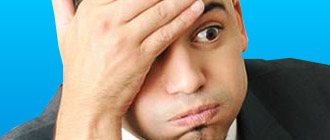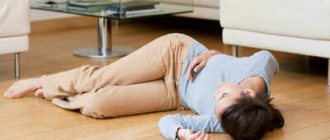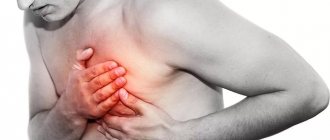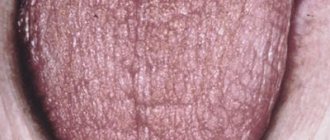September 6, 2018
Often, chronic illness occurs along with depression. Moreover, some of these diseases can cause it. According to statistics, a third of all patients suffering from chronic diseases are depressed. What are the symptoms? How to overcome depression? What kind of diseases provoke its appearance? Read about this in our article.
Symptoms of depression in chronic illness
For some people, chronic illness becomes part of their life. It lasts for a long time and most often does not heal completely. In this case, the condition of patients is controlled with the help of medications, physical activity and a special diet. Chronic diseases include diseases such as HIV, diabetes, arthritis, multiple sclerosis, etc.
It's not surprising that depression can occur when you have a chronic illness. After all, the disease significantly changes the patient’s usual lifestyle. For example, this manifests itself in limited ability to move independently and take care of oneself. Due to a chronic illness, the patient often has to give up favorite activities, which undermines his hope for a bright future. Under such circumstances, the patient begins to be overcome by sadness and despair. In addition, depression can be caused by physical aspects of the disease or side effects of medications used.
As for the symptoms, with a chronic disease they often go unnoticed, not only by the patient’s family, but also by himself. After all, when fighting an illness, most people consider constant depression and sadness to be completely normal manifestations. Often, the symptoms of depression are disguised as other physical ailments that treatment is aimed at combating. However, depression itself is not eliminated. After all, its treatment must be carried out separately.
Osteochondrosis - isn't it fatal? Interview with a doctor
— Why do some people experience osteochondrosis at an early age, while others do not have it even after 50?
— The reasons should also be looked for in the patient’s childhood — injuries, sluggish posture, and even in the way the birth took place — the consequences of birth trauma and difficult pregnancy can “resonate” throughout life. The most important cause of osteochondrosis is the weakness of the muscles of the spinal system, which, instead of maintaining it in a straightened state, “shirk” from their work, shifting it to the intervertebral discs. But the discs are not adapted to such work, so they begin to wear out, become thinner and lose moisture. This is what the trigger mechanism for osteochondrosis looks like.
- Symptoms of the disease. How can I determine that I have osteochondrosis?
— The simplest thing is to periodically listen to your feelings. The first sign of osteochondrosis is not pain, but a feeling of discomfort in the back, fatigue, stiffness - everything that we usually do not pay attention to, attributing it to overwork. A crunch in the neck and lower back should also alert you - this is how the discs signal to you that they lack moisture.
Back pain means that the nerve root is already suffering - perhaps the process has already gone far, and an intervertebral hernia - a dangerous complication of osteochondrosis - will have to be treated. Pay attention to the sensations in your arms and legs - numbness during the day or after waking up, “pins and needles”, nagging pain, muscle spasms, most likely indicate suffering of the nerve roots due to compression by a collapsing disc. Very often, such patients constantly have cold hands or feet, even in the summer heat.
Sometimes osteochondrosis is disguised as other diseases. Pain in the heart with a normal cardiogram is most likely cervical osteochondrosis, and an attack of renal colic with healthy kidneys is lumbar.
Headaches are frequent companions of osteochondrosis. Drinking painkillers by the handful is useless; their effect is temporary, and the root cause is hidden in irritation of the nerve roots of the cervical spine. So, if you have severe headaches, you need to go not to a therapist, but straight to a neurologist to have your spine examined.
— In principle, if your back doesn’t bother you much, maybe it doesn’t need to be treated? The disease is not fatal. What happens if osteochondrosis is not treated?
- Not fatal? I can argue with you. For example, a herniated disc in the cervical spine can damage the spinal cord and cause life-threatening conditions. And if left untreated, the knot of the disease will tighten tighter and tighter. Osteochondrosis is accompanied by a wide variety of accompanying diseases: hypertension and hypotension, the so-called vegetative-vascular dystonia.
Untreated cervical osteochondrosis increases the risk of heart attacks and strokes, the thoracic region affects internal organs - stomach, intestines, liver, kidneys; lumbar osteochondrosis causes such consequences as chronic inflammatory diseases of the pelvic organs. In women, this often leads to infertility, and in men, to impotence. Not to mention the fact that back pain gets worse over time, and other unpleasant symptoms increase every month and year.
— Modern methods of treating osteochondrosis.
- We have to disappoint you - there is no panacea! In the treatment of osteochondrosis, the key word is an integrated approach. Why? Judge for yourself - laziness of the internal muscles is to blame for the destruction of intervertebral discs, and there is no medicine that can teach them to work normally. And soon back problems are joined by such “neighbors” as hypertension and angina pectoris, varicose veins and arthritis, headaches and visual impairment, and every year the tangle of diseases becomes more and more entangled. For each component of such a “bouquet” you have to select a separate key. I'll tell you about some of them.
Kinesiotherapy is a type of static therapeutic exercises that works the internal muscles of the back, the deepest ones being those directly adjacent to the spine. Unfortunately, it is impossible to stir them up with ordinary exercises from a course of physical therapy. But, when using special techniques of this very effective technique, they respond perfectly and begin to work to restore posture.
You would be surprised if you saw how much pain people often come to this procedure with! An hour and a half of well-planned spinal stretching can relieve this pain. But the spine needs to be prepared for the load, because over many years of illness, its discs have thinned, the ligaments have dried out, and the muscles have become flabby and lifeless. The following methods work well with this.
Hirudotherapy is the therapeutic use of medicinal leeches. Hirudotherapy is especially good for those patients whose osteochondrosis is complicated by hypertension, vegetative-vascular dystonia, varicose veins, and cerebrovascular accidents. I would like to remind you that using a medicinal leech on your own at home is not only useless, but also dangerous.
Reflexology - or, in other words, acupuncture. Therapeutic effects - anti-inflammatory and analgesic - are often noticeable from the very first procedure. Reflexology is very helpful for headaches, including so-called migraines, neuralgia, radiculitis, and joint diseases. Amazing results can be achieved in the treatment of back pain, gynecological diseases and even infertility and male impotence.
- Can a person get rid of this disease on his own? What can you do yourself to alleviate your condition?
- It’s unlikely, it’s too complex, and usually obvious signs of the disease attract the owner’s attention when the disease has been going on for many years. Therefore, we can advise you to consult a doctor as soon as possible if alarm bells arise. You shouldn’t go to the other extreme - easily agree to surgery.
Although intervertebral hernia is a dangerous disease, it is still worth fighting for your health without surgery. My experience shows that even large intervertebral hernias - 6-12 mm - decrease in size and even go away completely. The main thing is to competently build a course of treatment.
Chronic diseases caused by depression
Of course, any serious illness can cause depression. The risk of its occurrence depends on two factors: the degree of complexity of the disease and changes in the patient’s life because of it. The risk of developing depression in men is 5-12%, while in women it is 10-25%. In the presence of a chronic disease, the risk of its occurrence increases to 33%.
Depression, which occurs with a chronic disease, worsens the patient's condition. This is especially true in cases where the disease does not allow him to lead a full life or causes severe pain or fatigue. Moreover, depression can increase pain and fatigue. At the same time, it can lead to the fact that the patient wants to isolate himself from society, which, most likely, will only worsen his condition.
Below are statistics on the occurrence of depression in various chronic diseases:
- stroke – from 10 to 27%;
- coronary artery disease – from 18 to 20%;
- diabetes – 25%;
- cancer – 25%;
- chronic pain syndrome – from 30 to 54%;
- multiple sclerosis – 40%;
- Parkinson's disease – 40%;
- heart attack - from 40 to 60%.
Afobazole
Afobazole is a domestic drug that has an anxiolytic effect and is used for anxiety conditions. incl. aggravated by somatic symptoms. The crazy rhythm of life in today's realities provokes a lot of health problems, one of which is anxiety disorders. To suppress such conditions, medicine can offer, for example, benzodiazepine tranquilizers or antidepressants. The problem is that these groups of drugs, in addition to their undeniable advantages, are also endowed with a number of disadvantages. A reasonable alternative for eliminating pathological anxiety may be the drug afobazole. Its use is not associated with adverse reactions characteristic of benzodiazepine tranquilizers - lethargy, drowsiness, muscle relaxation, impaired coordination of movement, which can worsen the quality of life. At the same time, afobazole has some advantages: low toxicity, the possibility of use in complex therapy without increasing the risk of adverse reactions, low risk of addiction and withdrawal syndrome. Thus, the drug, in its anxiolytic properties, practically corresponds to benzodiazepines and is suitable for long-term pharmacotherapy, because devoid of side effects typical of tranquilizers.
According to the mechanism of action, afobazole is a selective anxiolytic: the drug counteracts the development of membrane-dependent changes in gamma-aminobutyric acid receptors (GABA is the main inhibitory neurotransmitter). It does not have a sedative effect (unless, of course, you exceed the recommended dose tens of times). The pharmacological effect of afobazole is a combination of anti-anxiety and light activating components.
Already on the 5-7th day of taking the drug, there is a decrease or complete elimination of anxiety, irritability, anxious premonitions, tearfulness, phobias, and inability to relax. Against this background, combined somatic symptoms begin to disappear: muscular, cardiovascular, sensory, respiratory and digestive manifestations of pathological anxiety. The peak effect of afobazole occurs at the end of the 4th week and persists for another 1-2 weeks after discontinuation of the drug.
Clinical trials of afobazole took place in Russian psychiatric clinics and confirmed its high therapeutic activity in patients with an asthenic personality type, prone to excessive suspiciousness, self-doubt, increased vulnerability, and exposure to stress. The drug demonstrated maximum effectiveness for manifestations of anxiety combined with psychovegetative disorders, incl. with pain syndrome: when taking it, headaches, pain in the abdomen and in the heart area, and spinal pain were relieved. Afobazole does not have a negative effect on cognitive functions (memory, attention); on the contrary, having a slight stimulating effect, it improves some psychophysiological indicators.
Afobazole is available in tablets. The recommended single dose of the drug is 10 mg. The frequency of administration is 3 times a day. The duration of drug therapy varies in the range of 2-4 weeks. According to indications, the doctor can increase the daily dose of afobazole to 60 mg and extend the course of treatment to 3 months.
Treatment of depression in chronic diseases
For depression resulting from a chronic illness, you should contact a clinical psychologist. Its early diagnosis and proper treatment will help avoid possible complications and even suicide. There are often cases that successful treatment leads to an improvement in the general well-being and condition of the patient, and also gives new strength to fight a chronic disease.
If depression occurs due to a physical disability or as a side effect of medications used, the treatment plan must be changed. In other cases, it must be treated as a separate disease. In approximately 80% of patients, depression is eliminated through the use of appropriate medications, psychotherapy, or a combination of treatments. As a rule, antidepressants begin to work within a couple of weeks. But regular consultations with your doctor are necessary to choose the most suitable medicine.
Useful tips for depression due to a chronic illness
To avoid depression if you have a chronic illness, consider the following tips:
- If you feel depressed for a long time, then do not delay, but quickly consult a doctor.
- Communicate more with other people. Spend time with family and friends as often as possible. If you don't have anyone to talk to, ask your doctor about support groups where people with the same illness share their experiences with each other.
- Try to do things that interest you, unless it interferes with your treatment. Being active will allow you not to lose faith in yourself and be part of society.
- Find out more about your condition. Read various articles and stories of patients with the same disease as you. You can find something interesting for yourself in them.
- If you constantly experience pain, consult your doctor about possible ways to eliminate it or at least alleviate it.
- Make sure the doctor is really right for you. You must completely trust him and calmly discuss with him all your questions regarding the disease.
- If you suspect that a drug you are taking is causing depression, contact your doctor immediately to find a different drug for you, if possible.
Thus, if a chronic disease causes bouts of depression in a patient, this will negatively affect the overall course of his treatment. Living with such a disease is a difficult ordeal. Therefore, sadness and despair are a natural reaction to the ongoing struggle with the disease. But if depression does not leave the patient for a long time, and in addition there is a disturbance in food and sleep patterns, as well as loss of interest in favorite activities, then it is necessary to seek help from a clinical psychologist as soon as possible.









